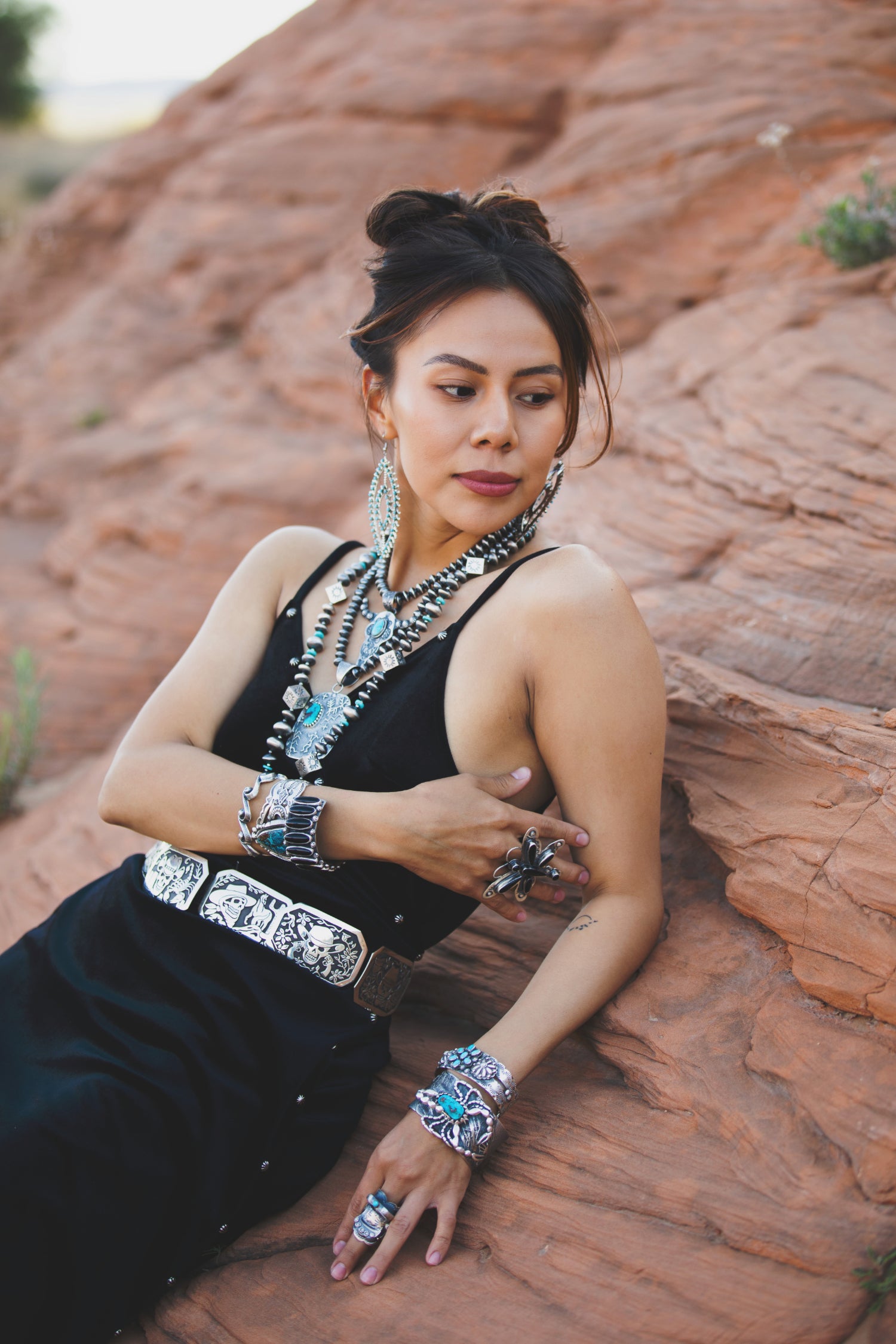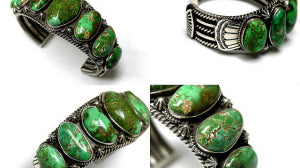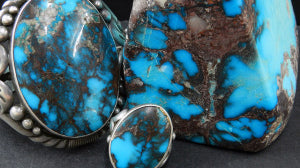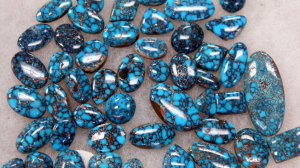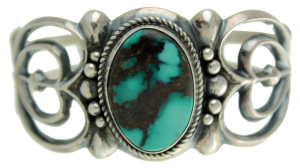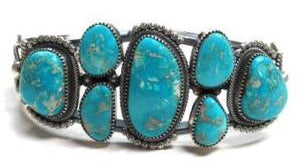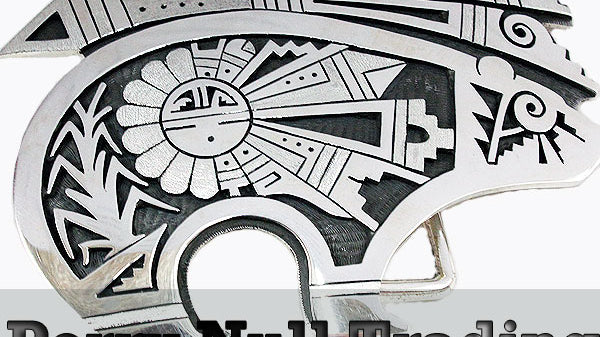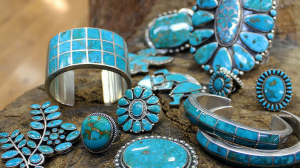Perry Null Trading
Carico Lake Turquoise
The Carico Lake mine is in Lander County, Nevada. The name comes from its location a few miles west of the dried up Carico Lake bed. Turquoise coming from the mine ranges from light green to a medium blue with a matrix of mostly limonite. Turquoise from this district has earlier been sold as Aurora and Stone Cabin turquoise. These mines had been run by August Stenich and later by J.W. Edgar, both legends in Nevada turquoise mining. Although today the Carico Lake mine is one of the larger producing mines in Nevada, high-grade turquoise from this mine is still fairly uncommon.
Bisbee Turquoise
Bisbee turquoise it is a by-product of a large copper mine located near Bisbee, Arizona owned by Phelps Dodge Mining Company with some of the finest turquoise coming from the section of the copper mine known as the "Lavender Pit," where for years copper miners would bring out fine turquoise in their lunch boxes. In March of 1972 a miner named Bob Matthews was given the only lease ever granted for rights to mine Bisbee turquoise. He was said to have recovered more than 2,000 pounds of good to excellent turquoise by 1974. The Bisbee is considered to be the first large open-pit copper mine in Arizona. As the pit was extended quantities of fine turquoise were recovered. The turquoise occurred in stringers up to a few inches wide along with small nugget-like masses in granite and quartzite.
Mining Turquoise, the Sky Stone
Crouched in dark tunnels, toiling while mining turquoise in sun scorched open pits or laboring in 100 foot shafts, prehistoric miners of the southwest swung heavy stone hammers into rock walls. They pried with picks made from antler and hefted shovels of bone and tortoise shell. They crushed and chiseled, extracting seams of turquoise from hard, country rock.
Lone Mountain Turquoise
The Lone Mountain turquoise mine is located in Esmeralda County, Nevada, not far from Tonopah. It has been one of the great producers of Nevada turquoise. The color ranges from a beautiful clear blue to a dark blue spider web. Lone Mountain has always been noted for holding its color. To this day jewelry can be found that was made in the 1930’s or 1940’s with Lone Mountain turquoise just as blue as when it was made.
King's Manassa Turquoise
King's Manassa turquoise mine is located east of Manassa, Colorado. It was mined for centuries by Indians and is thought to be the oldest turquoise mine in Colorado. It is the largest of many deposits in the area. I.P. King came upon the mine in 1890 while prospecting for gold. According to Bennett’s work on turquoise, "He thought the blue stain on the rocks was copper, but in 1900 it was identified as turquoise, and by 1908 ten claims were being worked nearby."
Godber-Burnham Turquoise (Drycreek)
The Godber-Burnham Turquoise mine is located northeast of Austin, Nevada on Dry Creek. In 1932 Bob Burton and Joe Potts discovered the mine and first claimed it as the "Last Chance.” Later, also being known as the "Blue Stone" and "Homesite" and at one time the "Dry Creek" due to its location along Dry Creek which runs through the Damele horse ranch and then in front of the Godber claim. The mine was later sold to Frank Burnham who it was reported took out more than $100,000 worth of turquoise. In 1934 Burnham sold the mine to Walter Godber.
Damele Turquoise
The Damele is a small mine about 30 miles northeast of Austin, Nevada. It sits adjacent to the Godber-Burnham claim. Very little Damele turquoise is being produced today and presently much is cut from older rough that can still be found from various turquoise dealers and collectors. Most of the material found today is a variscite, although some turquoise is still available. Damele turquoise is extremely hard, takes a nice polish and comes in a variety of colors from yellow, gold, greens and grays with a fine spider webbing. At its best it can be a beautiful gemstone. It is a well known mine with highly sought after cabochons and beads.
Cripple Creek Turquoise
The Cripple Creek turquoise mine is located in Teller County, Colorado near the town of Cripple Creek. Miners searching for gold in the area discovered turquoise. Cripple Creek turquoise is a very hard material, running to over 7 on the Moh’s scale, with a color varying from blue green to a true turquoise blue color. Sometimes found with a golden limonite matrix. It is seen as vein material and in nodules. There are two mines in the area but very little high-grade turquoise is being mined today.
Difference Between Navajo and Hopi Sterling Silver Overlay Jewelry
The thought is the Navajo silversmith first learned his craft from a Mexican platero. Then the Navajo taught both the Zuni and Hopi to make jewelry. So, in the beginning the jewelry being made was heavily influenced by Navajo design. Eventually this would change and the Zuni and Hopi silversmiths would develop a different look from the Navajo. For the Hopi the style would become silver overlay that incorporated traditional motifs into the jewelry.
Introduction to Pueblo Pottery
The young girl stood at the edge of the mesa facing the rising sun. She, her mother, aunt and grandmother whispered prayers in the dawn's first light: prayers for long life, health and well being. After breathing her prayers into the sacred cornmeal held in her hands, the girl threw the meal to the east, releasing her prayers to the wind.
Carved Zuni Fetishes an Introduction
For the past two centuries across the American southwest, in silent ruins and cave shelters, archaeologists have unearthed 1000 year old carved Zuni fetishes: duck-like birds of chalk turquoise, a frog of polished jet, birds of hematite, aragonite and tiny, turquoise tadpoles to name a few. Many of these items have holes drilled in them, possibly for cords to suspend about the neck. What did these objects signify and how were they used? For answers to these questions one must look to the modern day Zuni, the Native American tribe most noted for their fine, carved Zuni fetishes.
Blue Gem Turquoise
The Blue Gem Turquoise is a Nevada turquoise mine south of Battle Mountain in an area which produced large amounts of turquoise. Although there are a number of Nevada mines named Blue Gem this mine was in the Copper Basin area and surrounded by the Copper Canyon Mining Company in Northern Nevada. It was one of the larger producers of great turquoise and supplied material to the Southwest in nearly every shade of green and a variety of blues. The clear, intense blue color of this turquoise made it highly valued and widely used for both Zuni inlay and fine Navajo silver work. Blue Gem turquoise's hardness and fine colors makes this turquoise much sought after by both jewelers and collectors.

